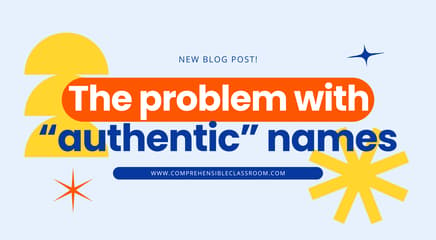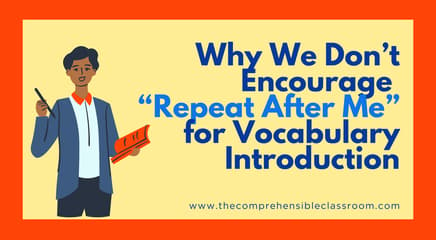I think that authentic resources are overrated.
This is coming from the lady that just presented at ACTFL on the importance of authentic resources, or ' #authres ', and how to use them in novice language classes... kind of a contradiction?
How important are authentic resources in a language curriculum?
#authres are important, but they are not everything. I was able to eek out two or three tweets on Saturday morning before taking off for errands, and after reading @SraSpanglish's fascinating Storify story on the topic, I wish that I had stayed home with a cup of coffee and tweeted all afternoon--not just because running errands with two babies is the pits, but because I missed out! Great conversation--and thanks to Laura Sexton for taking the time to narrate it in Storify!

What is an authentic resource?
An authentic resource is, by definition, any product that was created BY a native speaker FOR a native speaker. As Mira Canion once described it, the definition is incredibly narrow: too narrow, I would say, for using it as the criterion for which we include or exclude any given resource in class.
Who would use the resource, and why?
If we want to remain true to the definition, we end up splitting hairs. Take this infographic for example. It was created by the website www.speakinglatino.com, whose target audience is English speakers trying to learn Spanish. (I'm not sure whether the creator was a native speaker or not, but for the purpose of this example, it is irrelevant.) So. #authres? Nope. It was created (maybe) by a native speaker for a non-native speaker. However, I would not be surprised if there were native Spanish speakers out there that pinned this infographic and studied it because, for them, they could use it to learn the character names in English. So even though it was not created for native speakers of Spanish, it is useful and interesting to native speakers of Spanish to the same degree that it is to native speakers of English. But if we're being snooty pants with our narrow definition of #authres, then no, it is not. But is that to say that its value is any less?
Is the perspective authentic?
Another example is The Immigrant Archive Project, which I discovered when teaching the novel Esperanza by Wayside Publishing because it was included as an activity in the Teacher's Guide. The creators appear to be primarily native speakers of Spanish, and the target audience appears to be native speakers of English. Most of the interviewees are speaking in Spanish, but they know that this is for a project that will be documenting their stories with subtitles in English. So even though their language is authentic, none of the interviews on the website are truly authentic resources. Does that make them any less valuable?
Leveled readers are authentic to the classroom context
The conversation on the Storify story revolved around leveled readers by companies like Fluency Readers. I think that I love those novels more than just about anyone out there and would argue their value to the death because I have seen what they have done for my students' language acquisition and for the building of our community and their understanding of the world outside of Anchorage.
Unfortunately, the narrow definition of authentic resources excludes these novels. Most of the novels are not written by native speakers, and they are not written for native speakers. However, each novel is reviewed by at least three native speakers that confirm that the language is authentic. Furthermore, the novels are increasingly being used to improve Spanish language literacy and proficiency of native and heritage speakers of Spanish. So shall we ignore their usefulness simply because they do not fit our narrow definition?
What are the benefits of using authentic resources in class?
The reasons for examining authentic resources in language classes are numerous, and the research resonates with my experience. Here are some research-based reasons to work with #authres:

Here's the deal, folks. If you attended my ACTFL presentation, you heard me say that authentic resources are only as valuable as the communication that they foster. There is some value in trying to interpret a text that is completely incomprehensible to a student, since that is a real-world skill that they will encounter if and when they find themselves in the target culture, but there is great value in taking the time to make the products, practices, and perspectives found in the resource comprehensible to your students. In doing so, you are spurring your students on toward linguistic proficiency and intercultural competency. The two must go together.
Should students practice real world survival skills in class?
Instead of spending my class time giving "hunt and peck" or "make a guess" tasks to students that perhaps mimic the experience of being in the real world, I want to use the majority of our precious class time to increase their fluency.
Even in Comprehension-based courses, students practice problem solving as they encounter new language; however, they are solving problems that are actually solvable to them. This is the point of providing input at i+1; not i+8. The task of understanding the text well enough to facilitate communication in the target language is doable.
What are the benefits of using resources created for learners?
If we look at the slide from my presentation that lists ten research-supported reasons for the use of authentic resources in language classes, it is quite apparent that many of those benefits are achieved by non-authentic resources. #4 and #9 for example--that has Immigrant Archive Project written all over it! #10 is true of any text that is compelling!
When I was reading La Calaca Alegre, a Wayside Publishing novel by Carrie Toth, I literally could not put it down! I wanted to know what happened! And the whole time I was learning about the target culture through the murals of Hector Duarte and life in the Hispanic neighborhood of Pilsen, outside of Chicago. The same is true of my students as we read Esperanza and El Nuevo Houdini--the kids were not hung up in the least on the fact that Esperanza was written from the first person perspective or that we read El Nuevo Houdini in the past tense before we studied past tenses, because they were so focused on what was happening to the characters!
Reason #7 is true of anything that is interesting in life, period! It doesn't matter who created it or for whom it was created--you could talk about Miley freaking Cyrus sitting naked on a wrecking ball in Spanish! That will inspire some heated discussion! But it is certainly not authentic! And #3--motivate the learner??? Hellooooo don't we try to do that with any lesson? I could go on, but I think that you can see for yourself that all 10 benefits can be provided by selected non-authentic resources (with the exception of #8, which I think is silly anyway. I mean, come on. That's like saying "A circle is circular". Not helpful.)
The benefits of #authres are not exclusive to #authres
My point is that it is true that these are all benefits to using authentic resources in your classes, but they are not benefits that are exclusive to authentic resources. It would be foolish to ignore the challenges that authentic resources bring simply because we see that they have an impressive list of rewards.
How should we balance authentic resources and learner resources?
I guess I have three summarizing thoughts on the topic:
- It is not best practice to exclude a resource from use in your classroom simply because it is not, by narrow definition, an authentic resource, when it may in fact provide students with most or all of the benefits attributed to authentic resources.
- It is equally poor practice to include a resource simply because it is, by narrow definition, authentic, when it will not further your students' language acquisition and will surely frustrate and confound them. If they are frustrated and confounded, they will not access any of its benefits.
- It is not best practice to include an authentic resource without comprehensify-ing it--turning it into comprehensible input. (On that note--if you want to learn how to do this, then you should fly me out of cold Alaska to come visit your school and teach you about it ;-))
That's my summary... what's yours?




